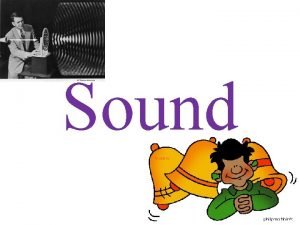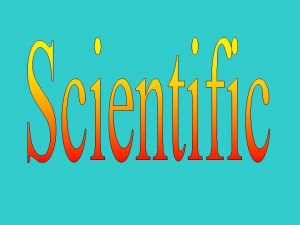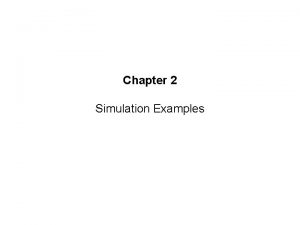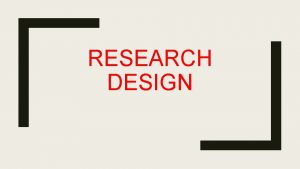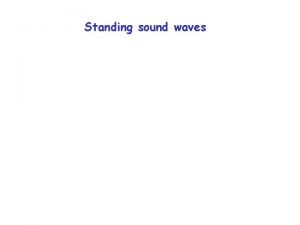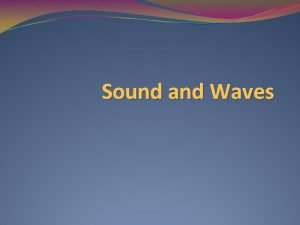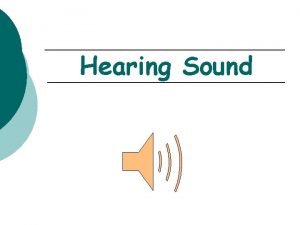Steps of a sound simulation study Formulate the












- Slides: 12

Steps of a sound simulation study Formulate the problem and plan the study. 1. a. Problem of interest is stated precisely b. Arrange a meeting of the team of simulation analysts and determine 1. the objectives of the simulation study 2. Specific questions to answer 3. Performance measure used to evaluate the efficiency of different system configurations 4. Scope of the model 5. System configurations to be modeled 6. Software to be used 7. Time frame for the study

2. Collect data and define a model Collect information on the system layout and operating procedures a. Collect data (if possible) to specify the model parameter and input probability distributions b. Collect data on the performance of the existing system (if possible) c. Build the model according to: 1. Project objectives 2. Performance measure 3. Data availability 4. Credibility concerns 5. Computer constraints 6. Opinions of subject matter experts 7. Time and memory constraints

3. Validate the model: perform a structural walk-through of the conceptual model, this a) Helps ensure that the model assumptions are correct and complete b) Promotes ownership of the model c) Takes place before programming begins 4. Construct a computer program and Verify a) Decide which computer program to use b) Construct the computer program and make sure it is verified.

5. Make pilot runs a) Use for validating the model b) Gives you how much more runs you need 6. Is the program model valid? Use the pilot runs to check whether the results obtained are consistent with the real world or not. 7. Design experiments. Decide how much simulation runs to be made for each alternative system

8. Perform the productive simulation runs that are used to estimate the performance measure 9. Analyze the output data. Use statistical techniques to analyze the output data obtained by the production runs (will discuss later) 8. Document, present, and use results

Monte Carlo Simulation p Solving deterministic problems using stochastic models. n p Example: estimate It is efficient in solving multi dimensional integrals.

Monte Carlo Simulation To illustrate, consider a known region R with area A and R 1 subset of R whose area A 1 in unknown. p To estimate the area of R 1 we can through random points in the region R. The ratio of points in the region R 1 over the points in R approximately equals the ratio of A 1/A. p R R 1

Monte Carlo Simulation p To estimate the integral I. one can estimate the area under the curve of g. n Suppose that M = max {g(x) } on [a, b] 1. Select random numbers X 1, X 2, …, Xn in [a, b] M R And Y 1, Y 2, … , Yn in [0, M] R 1 a 2. Count how many points (Xi, Yi) in R 1, say C 1 b 3. The estimate of I is then C 1 M(b-a)/n

Advantages of Simulation p p p Most complex, real-world systems with stochastic elements that cannot be described by mathematical models. Simulation is often the only investigation possible Simulation allow us to estimate the performance of an existing system under proposed operating conditions. Alternative proposed system designs can be compared with the existing system We can maintain much better control over the experiments than with the system itself Study the system with a long time frame

Disadvantages of Simulation produces only estimates of performance under a particular set of parameters p Expensive and time consuming to develop p The Large volume of numbers and the impact of the realistic animation often create high level of confidence than is justified. p

Pitfalls of Simulation p p p Failure to have a well defined set of objectives at the beginning of the study Inappropriate level of model details Failure to communicate with manager during the course of simulation Treating a simulation study as if it is a complicated exercise in computer programming Failure to have well trained people familiar with operations research and statistical analysis Using commercial software that may contain errors

Pitfalls of Simulation cont. p p p p Reliance on simulator that make simulation accessible to anyone Misuse of animation Failure to account correctly for sources of randomness in the actual system Using arbitrary probability distributions as input of the simulation Do output analysis un correctly Making a single replication and treating the output as true answers Comparing alternative designs based on one replication of each design Using wrong measure of performance










